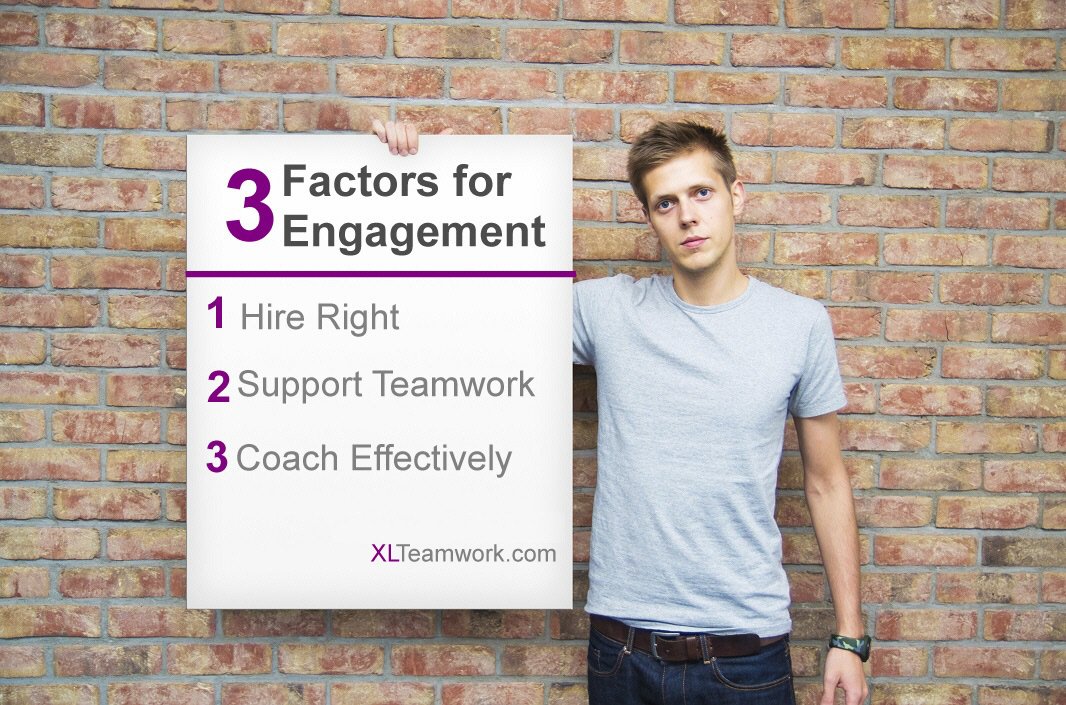Team Engagement: 3 Factors for Engagement Excellence

Can you tell the difference between an employee who is truly engaged, and one who isn't? Try looking at the difference in quality of service you receive.
On a recent business trip I was provided with the opportunity to experience and juxtapose some very different levels of service and employee engagement:
At a Tampa hotel, we were greeted by energized staff who went out of their way to assist us. We had also noted several employees at the airport who seemed to honestly enjoy helping the passengers. But then there was the disappointment I experienced during a visit to my preferred addiction supplier, Starbucks. When I arrived at the coffee house located in a Chapters store during what was clearly a slow period, three baristas were chatting behind the counter, and were unenthusiastic about interrupting the conversation to take my order. As I waited for my caffeine fix, my dissatisfaction with the service level was only amplified by the obvious lack of store cleanliness, with litter scattered on the floor and tables. If this was the consistent experience offered, would most brand loyalists return? I think not.
In any organization, a lack of engagement is costly. Disengaged staff often take more sick days, turn off more customers, lag in productivity and, when in management or on a team, can spread their "disengagement virus" faster than a runny nose in a day care.
Conversely, engaged staff create superior customer experiences, initiate innovative problem solving, and inspire their peers to greater performance - all factors that, when sustained, will contribute to the organization's bottom line. In his book Passion Capital, Paul Alofs discusses the energized, sustained, and strategically deployed engagement of associates as the most valuable asset an organization can have, using the equationPassion Capital = Energy + Intensity + Sustainability.
Customers and clients can certainly tell the difference between a team member who is engaged, and one who is not. Following a tour of the new Florida Hospital Wesley Chapel and their amazing 50,000 square foot wellness center, it was a pleasure to meet and speak with CEO Brian Adams. He is an engaged leader who sees the connection between engaged staff and excellence in patient care. From the person at reception, to security guards, to management team members, to the obvious pride that the VP of HR exhibited during the tour, it was clear that the level of engagement in their mission was high.
So how does an organization go about enhancing staff engagement? There is no single answer to this question - there are three areas that need to be integrated in order to both achieve and sustain a high level of engagement.
3 Important Factors for Engagement
1) Hire Right Fit Employees
Understand and align staff members' intrinsic motivators with the job. Don't hire Mother Teresa as a sales leader, or Donald Trump as the director of counselling for a homeless shelter. Mother Teresa was passionately engaged by helping and serving others, hence the work she did in Calcutta. Shark Tank's, Kevin O'Leary on the <span style="caret-color: rgb(40, 50, 78);">other hand</span>, is passionately engaged by profits from his business pursuits, and would likely not be energized in the same role.
2) Coach Your Staff Uniquely and Effectively
With the understanding that staff members have different styles and motivators, managers must learn how to coach them accordingly. Coaching Mother Teresa and Donald Trump requires two different approaches in order to engage their natural, intrinsic talents. Also, understanding how important the role of culture is, it can sometimes become necessary for managers to recognize poor fit and “coach them to be successful somewhere else.” As Alofs mentions in his book, “A culture of passion capital can be compromised by the wrong people. Tend the weeds.”
3) Engage Teamwork
Years ago I heard Jim Jacobus repeat the quote "Inside every human being, a champion heart beats." The challenge at times is, once you have a talented team of engaged champions, they need to work together. In 1984, when Bob Geldoff wrote Do They Know It's Christmas? and recruited talented celebrities to record it together, he knew enough to hang a sign at the entrance that said “Please leave your ego at the door.” Engaged people need to work together, respecting each others' unique passions, talents, and roles to accomplish the bigger purpose ahead of them. Imagine our human body as a team, driving a car. If the foot says to the eyes, “I’m the most important when it comes to controlling how fast we go” and the eyes respond by simply shutting, there might be some trouble reaching our destination. When engaged talents don’t work together well, it compromises productivity, performance and even talent retention. Again, in a “Coaching Culture” managers lead by leveraging engaged people in a way that cultivates their multiplied talents. As the saying goes “It takes teamwork to make a dream work.”
Hire Right, Coach Effectively, Embed Team Effectiveness, then stand back and observe engagement extended to customers and clients.
In the Spirit of Growth,
 | Chuck Reynolds is President and Chief Performance Officer of Excel Group Development in Toronto. He can be reached at (416) 481- 4802 or visit www.XLTeamwork.com for more information. |
Chuck Reynolds is President and Chief Performance Officer of Excel Group Development in Toronto. He can be reached at (416) 481- 4802 or visit www.XLTeamwork.com for more information.
Contact us to learn more about what we could do to make your team meeting a success.



